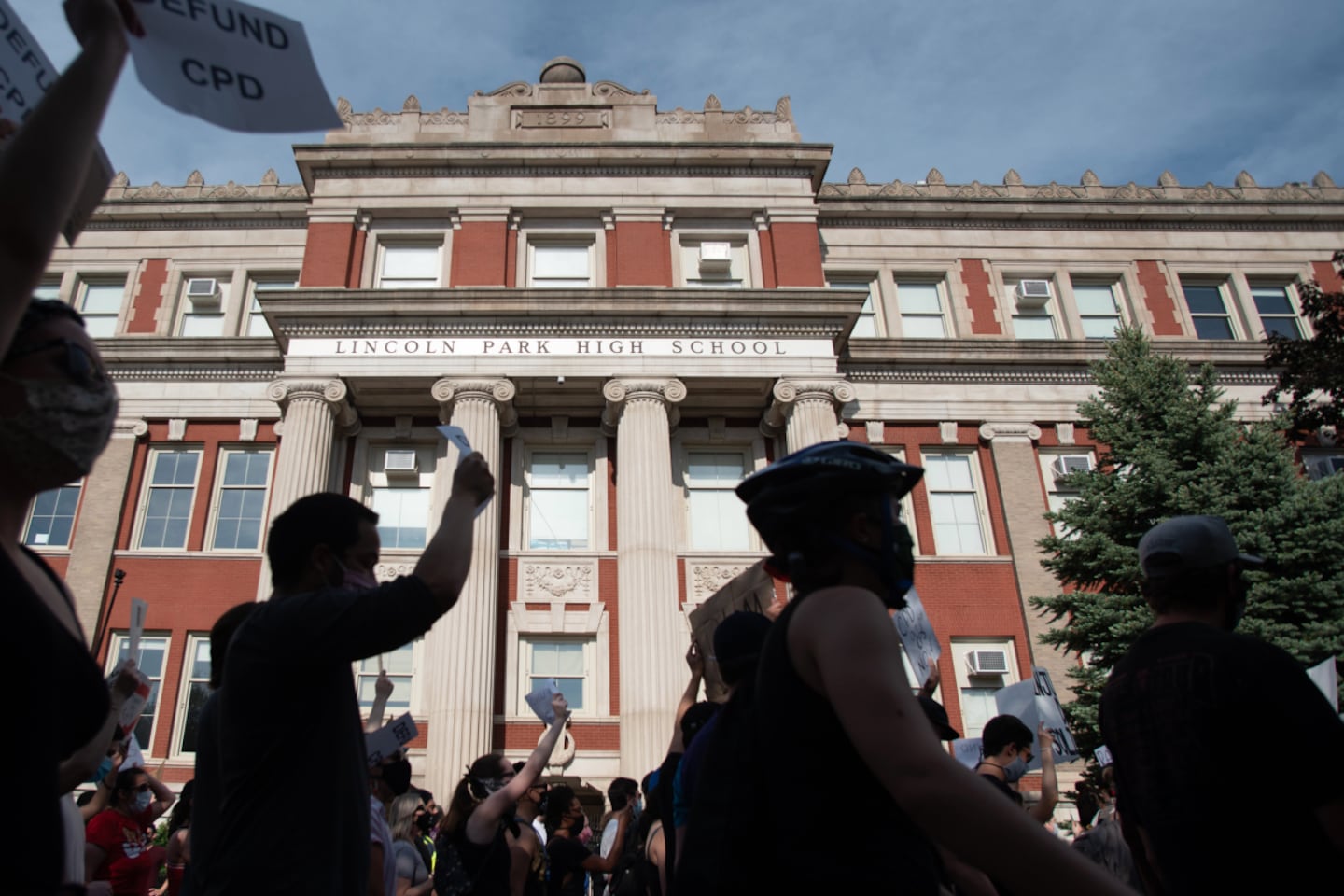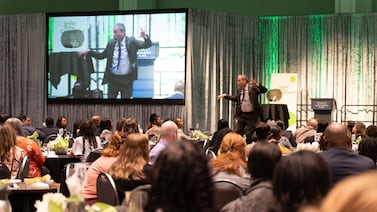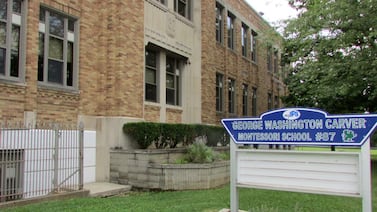As protests over police brutality and systemic racism rippled across the country this summer, long-time Chicago education activists saw their chance to win a battle they’d been waging for years: kicking police out of school buildings.
Mayor Lori Lightfoot and district leadership, refusing to remove police wholesale, punted the decision to each school’s governing council. Now, after weeks of often heated debate and a messy process, the vast majority of the 70-plus schools with police officers voted to keep them — including the majority of schools where the student body is majority Black.
The factors that led to the outcome are multifaceted and complex: Students armed with data about racial disparities in discipline ran headlong into parents and administrators who were grateful for the presence of police officers. While the role of police in schools was substantially narrowed last fall to take school discipline out of the picture, only allowing officers to intervene in cases of possible criminal activity, many felt uncomfortable voting to remove adults from already understaffed buildings. And in some cases, votes moved forward without quorums of council members or meetings that didn’t fully allow for student or community participation.
Activists say this isn’t the end of the conversation about school police in Chicago. But the overwhelming vote tallies in favor of the police program are likely to give the city’s school board cover when it takes up the police contract later this month. The board, already split on the issue of school police, will weigh continuing a significantly less expensive police contract this summer.
Ultimately, Chicago’s summer of school police votes shows a deep divide in how school communities feel about policing, and puts a new spotlight on longstanding problems with the transparency of school councils that have plagued some schools for years.
It also showed the stakes of any decision around policing in America today.
“Well, I’m not a police fan myself, because I am a Black man who lives in Chicago all his life,” said Dennis Thomas, a parent representative speaking at the Simeon Community Academy school police meeting this week. “I just like the fact that I can send my child to school and not worry, in case something does happen. I want my child to leave the building and be able to get home once they’ve left me.”
The view from one campus
At Simeon High School in Chatham, students, teachers, and council members painted an emotional picture of their experiences with police, reaching starkly different conclusions.
Principals and some council members in support of keeping officers said they needed police in case of a shooting or another incident where precious seconds could be lost getting help.
Students, teachers, and alumni pointed to decades of research, and their own experiences, of negative effects of armed police in schools on student academic achievement and mental health. Black students are arrested at disproportionate rates in Chicago schools.
Ashanti Haynes, former chair of the council at Simeon for three years, hearkened back to a tough school year, with a lot of fights, that cemented his opinion in favor of school police. “I watched the security guards be disrespected — and the only time that I actually witnessed things get under control was when CPD was on scene,” Haynes said. “We need a school resource officer in the school and we need to let our students know CPD is there for them, not to hurt them but to protect them.”
Ariam Abraham, a teacher in the English department, argued forcefully for a more restorative approach to discipline, which she said included removing officers. “My push is that we move the SROs because we all agree that is not the best option — not because it is helpful sometimes, not because we need more people,” said Abraham.
Principal Trista Harper spoke about incidents, both inside and outside of the school, in which she said school police were essential to ensuring student safety.
“I know the two officers in the building and I know what training that they’ve had,” Harper said during the three-hour virtual meeting.
To the teachers and students who continued to voice their concerns even after the vote was counted, Harper made a last plea: “I hear what you said, and I value what you said… I wish that we could sit down and have a more in-depth conversation about that as well.”
The meeting also included points of confusion around the process: members spent an hour and a half on other agenda items before the police vote, then cut speaking time for the public down to one minute per person, which some observers protested.
Many of the particulars were unique to Simeon. But the confused procedure, high emotions, and urgent nature of the meeting were not.
Participants at several schools said the rushed votes placed councils in an unprecedented position, making a historic, high-stakes decision with little training.
“Shame on you [CPS] for pushing this down to the LSCs,” said Laura Symons, a council member at Lane Tech, which voted Monday to remove officers. “I don’t have an office of equity. I don’t have an office of safety and security in my house that I can consult on these items [we have to vote on].”
At Lindblom Math and Science Academy, a selective enrollment school in Englewood, the student representative raised concerns that student polling on the issue appeared to be disregarded. “The people that want the SROs cut from Lindblom are the loudest,” Meredith Joncha said. “The people that don’t and feel [safe with SROs] are the quietest, yet their numbers are still shown” in the data.
Lindblom’s council voted in favor of keeping officers in early August, and then took a second vote this week. More than half of Lindblom staff and more than 75% of parents who responded were in favor of keeping officers on campus, as were about 43% of students.
Beyond the pressure and high visibility surrounding the votes, several councils failed to follow transparency rules requiring them to publicly post notice of meetings and spell out how parents and community members could log on. At Michele Clark, on the West Side, public comment was brief and no students spoke. No students attended the Wells Community Academy meeting.
At Marshall in East Garfield Park, where school officers were caught on camera last year dragging a student, whom they also tased, down the stairs in a high-profile incident, several concerns surfaced during the vote. That included whether there were enough council members present to hold a legal vote or if proper notice of the meeting was given in accordance with Open Meetings Act rules.
In total, more than a dozen schools voted without a full quorum, meaning their votes will be decided by the principal or network administrator, including Orr Academy, Chicago Military Academy, and Dunbar Vocational Career Academy.
In the end, each of these schools registered a vote to keep officers.
What tipped the scales
Of the 17 schools that voted to remove officers, more than half are on the city’s North Side, and only one has a majority Black student body.
They also had strong student organizing: Lane Tech students and alumni held a rally over the weekend, while students at Roosevelt High School, George Washington High School, Senn and North Park College Prep also held rallies or social media campaigns in recent weeks.
That helped push the discussion, council members said. “If there is one student that is hurt by having an [in-school police officer] here or doesn’t feel safe then we need to respect those students,” said Lane Tech council chair Emily Haite on Monday.
Time for nuanced discussion also appeared to make a difference.
A year ago, school councils were asked, with little notice, to vote on whether to keep their officers. All voted to keep them, though some students and teachers raised concerns about the process.
A year of conversation at Back of the Yards on the city’s South Side yielded a distinct change. In 2019, only one council member favored removing officers (one teacher representative abstained). By this month, the school had held several public meetings that allowed for deeper discussion and more public engagement. Rafael Yanez, a police officer and member of the Back of the Yards council, cast the sole vote against keeping officers in 2019.
At the time, said Yanez, the vote felt rushed and members had a lot of questions about how the program worked, with few answers.
This year, the council voted 6-5 against the SRO program. “I think the public meetings created a little bit more time to listen to testimonials and make a better informed decision,” said Yanez, whose police work includes visiting schools to give public safety precautions. This time, he voted again to remove officers.
Daniel Kramer, principal at Roosevelt High School, said at Tuesday’s meeting that he had a strong relationship with the officers that patrolled the halls of the Albany Park school, but that listening to student testimony had made him connect the vote to remove officers to broader racial justice demands.
“When I look at the students who have been arrested at Roosevelt High School, they are definitely disproportionately African Americans,” said Kramer. The student body at Roosevelt is 12% Black and 72% Latino. “This is part of a decision to take a hard and honest look at ourselves and say how are we supporting every one of our students.”
Looking ahead
The next big discussion about school police goes to the board of education, which will weigh the school police contract for a second time this summer on Aug. 26. The board previously voted 4-3 to keep the contract.
The public outcry around school police has already brought some shifts. Chicago Public Schools announced earlier this week, when it released a preliminary budget, that the maximum cost of the contract between the district and the city’s police department would be cut by more than half. That takes the contract from $33 million to $15 million by removing payment for officers on days they are not serving in schools and no longer paying for mobile patrol officers.
At least one prominent critic says that revision addressed his concerns about the school police program. Ald. Chris Taliaferro, who heads the city council’s public safety committee, had previously voiced concern that the contract included not only the pay but also benefits and pension costs for school officers. “It sounds like they have cut back where it’s not absolutely necessary,” he said.
Chicago Public Schools has also said it will work with schools who remove their police to develop alternative safety plans. With the school year beginning remotely, that urgency has shifted.
There is also an open question for the future of school councils: delayed local school council elections have been rescheduled for the fall, and the district will likely reopen the nomination process.
Coming out of the school police vote process, Raise Your Hand parent organizer and long-time council member Natasha Erskine said she fears the weeks of packed votes have only shown the council’s weaknesses, without a clear plan to fix them. “I’m heartened by the few councils who have really tried to take this moment and grow,” Erskine, who served on King College Prep High School’s council, said.
But in other cases, she’s seen fractured relationships and a lingering concern around the effectiveness of school councils themselves. “This is a very popular local participatory process,” she said. “I’m worried about how this current situation is going to impact that.”
Still, long-time opponents of the police program say the decision should never have fallen to individual schools, which they argue were underprepared for this moment and didn’t make information accessible. That was particularly a problem for non-English speaking parents and the students arguably impacted most by the presence of the officers.
Instead, they want to see the board of education take action, and say they’ll continue pushing for change. “You can’t address a systemic issue by dividing it up - the board of education needs to take leadership when it comes to this,” said VOYCE organizer Maria Degillo. “There are a lot of questions about how community voice is being included.”
Sneha Day and Block Club Chicago contributed reporting.








